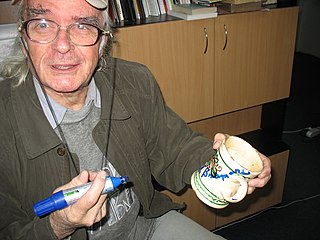
Nicolae Rădescu was a Romanian army officer and political figure. He was the last pre-communist rule Prime Minister of Romania, serving from 7 December 1944 to 1 March 1945.
The Sibiu Literary Circle was a literary group created during World War II in Sibiu to promote the modernist liberal ideas of Eugen Lovinescu.
Teofil Oroian is a Romanian Army officer and military historian.
Romanian architecture is very diverse, including medieval, pre-World War I, interwar, postwar, and contemporary 21st century architecture. In Romania, there are also regional differences with regard to architectural styles. Architecture, as the rest of the arts, was highly influenced by the socio-economic context and by the historical situation. For example, during the reign of King Carol I (1866–1914), Romania was in a continuous state of reorganization and modernization. In consequence, most of the architecture was designed by architects trained in Western European academies, particularly the École des Beaux-Arts, and a big part of the downtowns of the Romanian Old Kingdom were built during this period.

Dragoș Protopopescu was a Romanian writer, poet, critic, philosopher, and far-right politician.

Emil Brumaru was a Romanian writer and poet. He was renowned for his erotic poetry.

Dumitru Berciu was a Romanian historian and archaeologist, honorary member of the Romanian Academy.

Dumitru Almaș was a Romanian journalist, novelist, historian, writer and professor. His prolific output included children's literature, historical novels and textbooks. He was honored by both the Romanian Writers' Society and the subsequent Writers' Union of Romania. He also served as a member of the board of Society for Historical Sciences of Romania.

Ioan Alexandru Brătescu-Voinești was a Romanian short story writer and politician. The scion of a minor aristocratic family from Târgoviște, he studied law and, as a young man, drew close to the Junimea circle and its patron Titu Maiorescu. He began publishing fiction as an adolescent, and put out his first book of stories in 1903; his work centered on the fading provincial milieu dominated by old class structures. Meanwhile, after a break with Maiorescu, he drew toward Viața Românească and Garabet Ibrăileanu. In 1907, Brătescu-Voinești entered the Romanian parliament, where he would serve for over three decades while his written output declined. In his later years, he became an outspoken anti-Semite and fascist, a stance that, following his country's defeat in World War II, gave way to anti-communism near the end of his life.

Alexandru Rosetti was a Romanian linguist, editor, and memoirist.

Matei Socor was a Romanian composer and communist activist.
Mircea Sandu, known as Mircea Ciobanu, was a Romanian poet, writer, editor, translator and essayist.

Andrei-Nicolae Pippidi is a Romanian historian and professor emeritus at the University of Bucharest. He specialised in South-Eastern European history of the 15th–19th century, in Romanian history of the Middle Ages and the Early Modern Period, and in the relationship between South-Eastern Europe and the Occident.

Constantin Iancovescu (1862–1945) was a Romanian politician and general.

Romanian Revival architecture is an architectural style that has appeared in the late 19th century in Romanian Art Nouveau, initially being the result of the attempts of finding a specific Romanian architectural style. The attempts are mainly due to the architects Ion Mincu (1852–1912), and Ion N. Socolescu (1856–1924). The peak of the style was the interwar period. The style was a national reaction after the domination of French-inspired Classicist Eclecticism. Apart from foreign influences, the contribution of Romanian architects, who reinvented the tradition, creating, at the same time, an original style, is manifesting more and more strongly. Ion Mincu and his successors, Grigore Cerchez, Cristofi Cerchez, Petre Antonescu, or Nicolae Ghica-Budești declared themselves for a modern architecture, with Romanian specific, based on theses such as those formulated by Alexandru Odobescu around 1870:
"Study the remains – no matter how small – of the artistic production of the past and make them the source of a great art (...) do not miss any opportunity to use the artistic elements presented by the Romanian monuments left over from old times; but transform them, change them, develop them ..."

Ștefan Protopopescu was a Romanian officer and aviation pioneer, he held the no. 1 pilot license in Romania, being the first licensed pilot in Romania and the first pilot of the Romanian Army.
Events from the year 1949 in Romania. The year saw the introduction of collectivization and the first Romanian identity card.

The German Military Mission in Romania was a mission led by lieutenant general Erik Hansen, and sent from Nazi Germany to help Romania during World War II. German officers and aviators trained and supported the Romanian army from October 1940 to August 1944.













